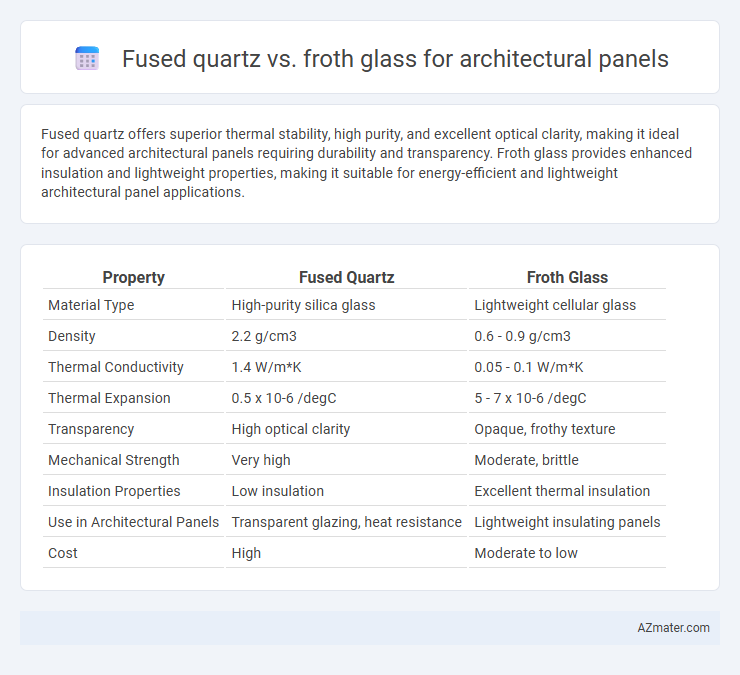Fused quartz offers superior thermal stability, high purity, and excellent optical clarity, making it ideal for advanced architectural panels requiring durability and transparency. Froth glass provides enhanced insulation and lightweight properties, making it suitable for energy-efficient and lightweight architectural panel applications.
Table of Comparison
| Property | Fused Quartz | Froth Glass |
|---|---|---|
| Material Type | High-purity silica glass | Lightweight cellular glass |
| Density | 2.2 g/cm3 | 0.6 - 0.9 g/cm3 |
| Thermal Conductivity | 1.4 W/m*K | 0.05 - 0.1 W/m*K |
| Thermal Expansion | 0.5 x 10-6 /degC | 5 - 7 x 10-6 /degC |
| Transparency | High optical clarity | Opaque, frothy texture |
| Mechanical Strength | Very high | Moderate, brittle |
| Insulation Properties | Low insulation | Excellent thermal insulation |
| Use in Architectural Panels | Transparent glazing, heat resistance | Lightweight insulating panels |
| Cost | High | Moderate to low |
Understanding Fused Quartz and Froth Glass
Fused quartz, characterized by its high purity and exceptional thermal stability, offers superior transparency and durability for architectural panels, making it ideal for environments requiring resistance to thermal shock and chemical corrosion. Froth glass, produced by introducing gas bubbles into molten glass, provides lightweight insulation and soundproofing properties with a unique translucent appearance suited for energy-efficient building facades. Comparing the two, fused quartz excels in mechanical strength and optical clarity, while froth glass emphasizes thermal insulation and aesthetic versatility in architectural applications.
Composition and Manufacturing Processes
Fused quartz is composed of high-purity silica (SiO2) melted at temperatures above 1700degC to achieve a homogeneous, non-crystalline solid with exceptional thermal stability and transparency. Froth glass, also known as cellular or foam glass, is produced by mixing finely ground glass cullet with foaming agents and heat-treated between 700-900degC to create a lightweight, porous structure with insulating properties. The manufacturing process of fused quartz involves melting and isotropic solidification, while froth glass requires controlled foaming and sintering to trap gas bubbles within the glass matrix, resulting in distinct material characteristics suited for architectural panels.
Physical Properties Comparison
Fused quartz offers superior thermal stability with a melting point around 1,710degC, significantly higher than froth glass, which softens near 700degC. Its low thermal expansion coefficient (approximately 0.5 x 10^-6 /degC) ensures excellent resistance to thermal shock, whereas froth glass exhibits higher expansion, making it less stable under temperature fluctuations. The density of fused quartz (~2.2 g/cm3) is greater than that of froth glass (typically 0.2-0.5 g/cm3), providing enhanced structural strength for architectural panel applications.
Visual and Aesthetic Differences
Fused quartz offers exceptional clarity and a smooth surface ideal for architectural panels requiring a sleek, minimalist look with superior light transmission. Froth glass features a textured, frosted appearance that diffuses light, providing a matte finish suitable for privacy and decorative, artistic installations. The visual choice between the two depends on whether transparency and glossiness (fused quartz) or translucency and texture (froth glass) better suit the architectural design intent.
Thermal Resistance and Insulation
Fused quartz offers superior thermal resistance with a melting point around 1,650degC, making it highly effective for heat insulation in architectural panels, especially in environments with extreme temperatures. Froth glass, created from recycled glass with a cellular structure, provides excellent thermal insulation due to its low thermal conductivity and lightweight nature, enhancing energy efficiency in building designs. Both materials optimize thermal performance, but fused quartz excels in high-temperature resistance, while froth glass is preferred for cost-effective, sustainable insulation solutions.
Strength and Durability Factors
Fused quartz exhibits exceptional strength and durability for architectural panels due to its high thermal stability, low thermal expansion coefficient, and resistance to chemical corrosion, making it ideal for environments with extreme temperature fluctuations. Froth glass offers lightweight structural support with good compressive strength and impact resistance but generally has lower thermal resistance and may degrade faster under prolonged exposure to UV radiation and moisture. This makes fused quartz preferable for applications demanding long-term performance and minimal maintenance in harsh conditions.
Sustainability and Environmental Impact
Fused quartz offers superior sustainability for architectural panels due to its high durability, recyclability, and energy-efficient production process with low CO2 emissions compared to traditional glass. Froth glass, made from recycled glass and lightweight materials, provides excellent thermal insulation and reduces landfill waste by repurposing industrial byproducts. Both materials contribute to green building certifications, but fused quartz's longer lifespan and lower maintenance requirements enhance its environmental impact advantage.
Cost Analysis: Fused Quartz vs Froth Glass
Fused quartz panels typically incur higher initial costs due to their superior thermal stability, low thermal expansion, and high durability, making them ideal for high-performance architectural applications. Froth glass panels offer a more cost-effective solution with lower material and manufacturing expenses but may compromise on strength and thermal resistance compared to fused quartz. When evaluating cost analysis, froth glass provides budget-friendly options for large-scale projects, while fused quartz justifies its premium price in environments demanding exceptional durability and thermal performance.
Applications in Architectural Panels
Fused quartz offers exceptional thermal stability and low thermal expansion, making it ideal for high-performance architectural panels exposed to extreme temperature variations. Froth glass, with its lightweight and excellent insulation properties due to closed-cell structure, is preferred for energy-efficient building facades and interior wall panels. Both materials enhance facade durability, with fused quartz suited for structural glazing systems and froth glass favored for sustainably insulating architectural panels.
Choosing the Right Material for Your Project
Fused quartz offers exceptional thermal stability and transparency, making it ideal for architectural panels requiring high durability and minimal thermal expansion. Froth glass provides superior insulation and lightweight properties, suited for energy-efficient designs where weight reduction is a priority. Selecting the right material depends on project-specific needs such as thermal performance, structural requirements, and aesthetic goals.

Infographic: Fused quartz vs Froth glass for Architectural panel
 azmater.com
azmater.com